I have a Ka-1 amp that's new to me. Just testing with a poor speaker, I hear both channels sound different. One also warms up politely, while the other is cold. I can swap the L&R pre to main audio cables, and the sound difference follows them. So I believe the issue is within the preamp section. I need to test again to see if the other channel then warms. I presume so, but am testing for that, now I'm aware of the temperature discrepancy.
Lets have a look
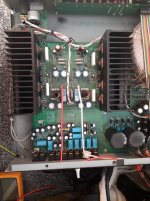
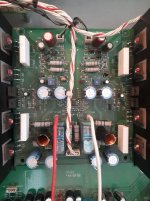
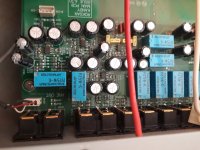
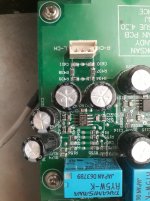

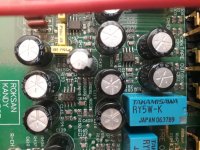
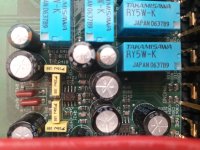
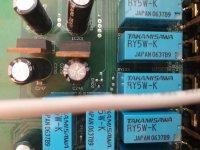
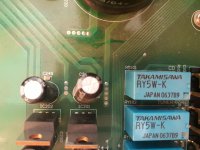
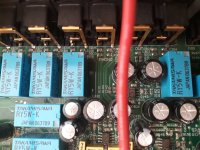
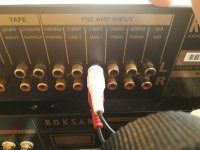

I'm impressed I can post so many pics in one go. Though some have spun around, disorienting even me, and I have the thing in front of me. I hope it's not too much hard work for people.
The final image, I posted larger, is my initial thoughts. Firstly, I seem to have too many relays. I feel the Red one is outstanding, and might route everything through it, even after individual switching. It seems odd, but wishful thinking suggests an easy target. I have a phono amp in yellow. I wouldn't be surprised if the pink amp was part of it, or the two green 'Dished' caps. The green amp a buffer for the tape loop. The black one, the only one common to the couple of different inputs I have connected my CD player to, and seen the same fault. So have I narrowed it down to a very small area.. maybe. It has two dished caps I guess are on power, but shared by both channels. Then two more on the output side of things, I could swap over.
I have metered the preout, and it looked.. like I need to finally buy a scope. I see 35khz on both channels. No AC. DC of 2v and dropping. In about 30 seconds, they were down to a volt. One about 0.2v higher and I did a cold start a few times looking at this.
I guess I could now bypass the preamp completely, and inject my cd player straight into the power amp. Or bring the preamp signal out, to another amp. I have noted the main amp sits in protect if the preamp isn't connected to it. So this DC means something. I don't know. I have only an inquisitive mind. No training.
I have fancied a scope for years. Maybe 50. I have no funds or space for a desktop item, but see Ali has things from £20 now. Some are a basic multimeter at a glance, but are doing something. Has anyone messed about with these. I don't need 27mhz anymore. Just something to look at audio waves comparatively. Will anything do really? I would like to eye up a CD player I guess, but this item will live forever in it's box, and maybe never meet a real signal generator. I don't imagine I need much?
Lets have a look











I'm impressed I can post so many pics in one go. Though some have spun around, disorienting even me, and I have the thing in front of me. I hope it's not too much hard work for people.
The final image, I posted larger, is my initial thoughts. Firstly, I seem to have too many relays. I feel the Red one is outstanding, and might route everything through it, even after individual switching. It seems odd, but wishful thinking suggests an easy target. I have a phono amp in yellow. I wouldn't be surprised if the pink amp was part of it, or the two green 'Dished' caps. The green amp a buffer for the tape loop. The black one, the only one common to the couple of different inputs I have connected my CD player to, and seen the same fault. So have I narrowed it down to a very small area.. maybe. It has two dished caps I guess are on power, but shared by both channels. Then two more on the output side of things, I could swap over.
I have metered the preout, and it looked.. like I need to finally buy a scope. I see 35khz on both channels. No AC. DC of 2v and dropping. In about 30 seconds, they were down to a volt. One about 0.2v higher and I did a cold start a few times looking at this.
I guess I could now bypass the preamp completely, and inject my cd player straight into the power amp. Or bring the preamp signal out, to another amp. I have noted the main amp sits in protect if the preamp isn't connected to it. So this DC means something. I don't know. I have only an inquisitive mind. No training.
I have fancied a scope for years. Maybe 50. I have no funds or space for a desktop item, but see Ali has things from £20 now. Some are a basic multimeter at a glance, but are doing something. Has anyone messed about with these. I don't need 27mhz anymore. Just something to look at audio waves comparatively. Will anything do really? I would like to eye up a CD player I guess, but this item will live forever in it's box, and maybe never meet a real signal generator. I don't imagine I need much?
I have spun off on a tangent regarding the caps. It seems the common dumpy 100uf 16v here, is in the signal path. The others, have all dished. Except at the regs we see. Just off shot, are a 12v and a 5v reg, on heatsinks, that have both domed their 16v 470uf green caps. I think the 5v might just be for the relay coils, and so a 16v cap doming perhaps speaks of a problem upstream. The main caps are 8200 and were the first things I looked at. They have a plastic disk top, but they do curve. Oddly half the amp sounds reasonable on my little tv speaker (them white coned one's a few of us were playing with)
I have never seen what happens, if turning an amp up, empties the main smoothing caps. The outcome of under feeding regs, that expect to be getting a few volts more than they should be supplying.
Maybe I'm wrong, and I have seen the outcome, right here
I have never seen what happens, if turning an amp up, empties the main smoothing caps. The outcome of under feeding regs, that expect to be getting a few volts more than they should be supplying.
Maybe I'm wrong, and I have seen the outcome, right here
Realised the 2v dc must be the caps, from the start up surge. Nowhere to go with the plug off, so plug on.. unsettling. They dropped near nothing, than rose to 20mA and settled back about 11mA with a 2mA differential between them. Not a smoking gun
I think them two caps in the signal path, along with the handful of smoothing caps is a good move. I might have some main smoothing caps, but if not, the price is getting a bit much for random part swaps. They are 80v and fitting £5 rubbish one's isn't excusable. The two in the signal path really have me avoiding ebay though. I have an Onkyo with the failed dsp, so might have a dig in there.
I think them two caps in the signal path, along with the handful of smoothing caps is a good move. I might have some main smoothing caps, but if not, the price is getting a bit much for random part swaps. They are 80v and fitting £5 rubbish one's isn't excusable. The two in the signal path really have me avoiding ebay though. I have an Onkyo with the failed dsp, so might have a dig in there.
Did I say mA. I meant mV
Are coupling caps not usually bigger than 100uf?
I might swap those in the black area, for those near the tape loop. The loop will never get used, and eBay won't provide anything decent
Are coupling caps not usually bigger than 100uf?
I might swap those in the black area, for those near the tape loop. The loop will never get used, and eBay won't provide anything decent
Last edited:
I have spent a tenner on caps. The 80v 8200uf main one's, and the 8 smaller one's that have visually failed. Hopefully the 35khz will vanish if I gain some stability, and that might be the end of it. I don't really want to lift the board until I'm ready to do some work on it, so I will pause this job for now.
I wonder if I can take pics from both sides of the board, flip and stretch them about, and then lay them up using MSpaint transparency. There must be a program out there by now, that can look at old boards and produce a schematic. All the big shops should have one. What's it called?
I wonder if I can take pics from both sides of the board, flip and stretch them about, and then lay them up using MSpaint transparency. There must be a program out there by now, that can look at old boards and produce a schematic. All the big shops should have one. What's it called?
The visibly failed power cap replacements have cleared customs.
I don't feel happy about them. Two types failed, and though the amp might be 20yo, I have not seen anything take all it's caps in this manner. Ideas like lightening strike, or failed solar inverter don't seem far fetched, and I have found the transformer wires actually plug to the board. They are not soldered on. My mind just isn't sitting comfortably. If the amp is simply cooked (it's over 400rms 4ohm) then should I really be changing the caps in the audio path between stages. It does have a poor sounding channel, so it's a bit hopeful that a shared power issue is effecting just one channels sound quite drastically.
Them coupling caps are only 100uf. I'm a bit late to be ordering some, but perhaps I really should. It's not a board I want to keep pulling out. I'm not really sure what to order though. 100uf 16v np in there. Which can be £0.05 or £5.00
I don't feel happy about them. Two types failed, and though the amp might be 20yo, I have not seen anything take all it's caps in this manner. Ideas like lightening strike, or failed solar inverter don't seem far fetched, and I have found the transformer wires actually plug to the board. They are not soldered on. My mind just isn't sitting comfortably. If the amp is simply cooked (it's over 400rms 4ohm) then should I really be changing the caps in the audio path between stages. It does have a poor sounding channel, so it's a bit hopeful that a shared power issue is effecting just one channels sound quite drastically.
Them coupling caps are only 100uf. I'm a bit late to be ordering some, but perhaps I really should. It's not a board I want to keep pulling out. I'm not really sure what to order though. 100uf 16v np in there. Which can be £0.05 or £5.00
The 5532 wiki page falls in line with poor psu caps leading to me 35khz oscillation, that manifests as audible distortion.
I can't figure the capacitors. I have looked at many 5532 amps, and most use just 1uf to route the sound out. The next most popular choice, is no cap at all. 10uf isn't that common, and the 100uf in mine is actually big, though I had seen a 470uf used, and thought maybe 100uf was small. I know the bigger cap is likely to pass lower frequencies, but if 1uf is working, 100uf seems overkill. I'm starting to think it's physical size is it's reason to be there. Bigger plates, for lower resistance. Getting towards that 'no cap' connection, but still with dc blocking.
If I stick with 100uf, I can forget polypropylene caps. They would be massive, and way out my budget. I think I could come lower, but just don't know for sure. So I'm looking at audio electrolytics from Elna or Nichicon. The Nichicon ES Muse seems the poor mans functional cap?
I can't figure the capacitors. I have looked at many 5532 amps, and most use just 1uf to route the sound out. The next most popular choice, is no cap at all. 10uf isn't that common, and the 100uf in mine is actually big, though I had seen a 470uf used, and thought maybe 100uf was small. I know the bigger cap is likely to pass lower frequencies, but if 1uf is working, 100uf seems overkill. I'm starting to think it's physical size is it's reason to be there. Bigger plates, for lower resistance. Getting towards that 'no cap' connection, but still with dc blocking.
If I stick with 100uf, I can forget polypropylene caps. They would be massive, and way out my budget. I think I could come lower, but just don't know for sure. So I'm looking at audio electrolytics from Elna or Nichicon. The Nichicon ES Muse seems the poor mans functional cap?
Hi friendly1uk,
Cheap and small. Well, you can try it. Maybe one could argue something is better than nothing. Sometimes it is the opposite case if it lies to you.
My friendly advice after decades of service and extensive experience with digital and analogue scopes? Buy a large hulking monster (by your standards) scope. Analogue, not digital. Get a good one used. An analogue scope shows you more detail, and it is more robust for errors on your part. You will make "goofs". Everyone does. Otherwise, you are looking at expensive, small and digital. Digital scopes with decent analogue performance are expensive as sin.
Cheap and small. Well, you can try it. Maybe one could argue something is better than nothing. Sometimes it is the opposite case if it lies to you.
My friendly advice after decades of service and extensive experience with digital and analogue scopes? Buy a large hulking monster (by your standards) scope. Analogue, not digital. Get a good one used. An analogue scope shows you more detail, and it is more robust for errors on your part. You will make "goofs". Everyone does. Otherwise, you are looking at expensive, small and digital. Digital scopes with decent analogue performance are expensive as sin.
Thanks for the reply
I'm hoping I don't need the scope, having got through many years without one. The times I needed one, and managed without, are adding up now. I think in this amps case, I will probably probe about, and simply listen to my test points with a headphone amp. If it sounds right, it is right. Though I would of loved to hear that £30 scope was alright, a week back when I was hovering over it. The resolution actually seems ok, but what looks like a tablet size, is actually half a phone. So I might actually loose it around the house, rather than it need it's own bench 🙂
Fingers crossed I can muddle through again.
I found a thread on the Nichicon ES Muse, and I'm not seeing any reason to spend more
They say transparent to some serious testing gear, in the situation I want them for. I got a little pat on the back regarding the 100uf really being about low impedance to. So they are highly suited to the job, and only the postage costs anything. I just need to see who's postage is less then the 10,000uf smooth caps cost from China. Likely nobodies.
I'm hoping I don't need the scope, having got through many years without one. The times I needed one, and managed without, are adding up now. I think in this amps case, I will probably probe about, and simply listen to my test points with a headphone amp. If it sounds right, it is right. Though I would of loved to hear that £30 scope was alright, a week back when I was hovering over it. The resolution actually seems ok, but what looks like a tablet size, is actually half a phone. So I might actually loose it around the house, rather than it need it's own bench 🙂
Fingers crossed I can muddle through again.
I found a thread on the Nichicon ES Muse, and I'm not seeing any reason to spend more
Hi folks, as a few of you may know from my occasional posts, one of the DIY areas I tend to focus on is design of composite amplifiers. The performance of well executed composite amplifiers tends not to be measureable as it exceeds that of high end test and measurement equipment (more on this a few pages in on the Modulus-86 thread if you're interested) and the most attractive approach in a design I'm currently working on is DC blocking caps. I wished to know if the capacitors would limit performance.
It happens I'm in Seattle on a business trip this week. So I made arrangements...
It happens I'm in Seattle on a business trip this week. So I made arrangements...
Just when I thought it was safe to walk away...
My preamp section uses these 100uf 16v generic looking caps, then the main amp also has 100uf 16v caps at the input. Cerafines.
My head just exploded. Why would they change caps, from one side of the volume control, to the other.
My preamp section uses these 100uf 16v generic looking caps, then the main amp also has 100uf 16v caps at the input. Cerafines.
My head just exploded. Why would they change caps, from one side of the volume control, to the other.
Hi friendly1uk,
Stop. Take a breath. Put your thinking cap on.
Some in-depth tests have been done on coupling capacitors. These are not subjective listening tests, and we testing folks also listen very carefully. Read them. Wurth also put out a couple papers lately. I'll just add these agree with decades of testing and listening tests on my part and many others.
There are a couple of reasons why we have audio capacitors. Some are good caps, marketed as such and for audio. There are some sold purely for marketing reasons, here a great story accompanies them. Then we have the different and exotic caps, normally inferior but with a great story. Components do not have a memory, they have no clue whether the signal is noise, music or a control signal. Nor does it matter.
An oscilloscope is a very basic and essential bit of kit. You absolutely do require one. Like a Doctor that can tell everything by symptom and basic tests, that gets you so far. But that doctor is dangerous to everyone around them. This also only works if you have deep experience with what you are doing. You also need a very good meter and a low distortion signal source and very good THD meter or audio analyser. To get something functioning you may not need some of these things, but it would be massively easier to have the right instrument.
I get equipment in all the time, just repaired by someone who doesn't need a THD meter "because they can hear distortion by ear". The equipment isn't working properly and has very high distortion if not gross faults. The previous person believes with all their heart they are a great tech and equipment is a waste of time. They charge a lot for their "services". Whether you are a technician charging for your work or not, you are doing the same job. You need similar equipment. In your case maybe not as good, but you need that stuff. If you get it, go back and check your previous work. There is an education lurking there. One Carver amp came in with almost 2% THD, the customer said it sounded fine. After it was repaired and returned to service, the customer said "I can't believe I thought it sounded okay". This also says a great deal about listening tests. They need to be done in comparison or under the right circumstances.
Your filter capacitors. Most are fine. Use your oscilloscope to see the ripple waveform across the capacitor. Do not increase capacitor size if they do need replacement. By the way, the waveform across the filter capacitor tells you more than ad copy, personal accounts on performance or price. This requires some practice and skill of course.
They may use different capacitors on the control for marketing reasons, price considerations or available stock. Two PCBs may have been made at different times or in different locations. Manufacturing does follow the same ideals an audiophile may. So don't look for reasons beyond the most obvious from a manufacturing point of view.
Stop. Take a breath. Put your thinking cap on.
Some in-depth tests have been done on coupling capacitors. These are not subjective listening tests, and we testing folks also listen very carefully. Read them. Wurth also put out a couple papers lately. I'll just add these agree with decades of testing and listening tests on my part and many others.
There are a couple of reasons why we have audio capacitors. Some are good caps, marketed as such and for audio. There are some sold purely for marketing reasons, here a great story accompanies them. Then we have the different and exotic caps, normally inferior but with a great story. Components do not have a memory, they have no clue whether the signal is noise, music or a control signal. Nor does it matter.
An oscilloscope is a very basic and essential bit of kit. You absolutely do require one. Like a Doctor that can tell everything by symptom and basic tests, that gets you so far. But that doctor is dangerous to everyone around them. This also only works if you have deep experience with what you are doing. You also need a very good meter and a low distortion signal source and very good THD meter or audio analyser. To get something functioning you may not need some of these things, but it would be massively easier to have the right instrument.
I get equipment in all the time, just repaired by someone who doesn't need a THD meter "because they can hear distortion by ear". The equipment isn't working properly and has very high distortion if not gross faults. The previous person believes with all their heart they are a great tech and equipment is a waste of time. They charge a lot for their "services". Whether you are a technician charging for your work or not, you are doing the same job. You need similar equipment. In your case maybe not as good, but you need that stuff. If you get it, go back and check your previous work. There is an education lurking there. One Carver amp came in with almost 2% THD, the customer said it sounded fine. After it was repaired and returned to service, the customer said "I can't believe I thought it sounded okay". This also says a great deal about listening tests. They need to be done in comparison or under the right circumstances.
Your filter capacitors. Most are fine. Use your oscilloscope to see the ripple waveform across the capacitor. Do not increase capacitor size if they do need replacement. By the way, the waveform across the filter capacitor tells you more than ad copy, personal accounts on performance or price. This requires some practice and skill of course.
They may use different capacitors on the control for marketing reasons, price considerations or available stock. Two PCBs may have been made at different times or in different locations. Manufacturing does follow the same ideals an audiophile may. So don't look for reasons beyond the most obvious from a manufacturing point of view.
It's one PCB, but a lot suggests it may of been two, at the design stage. The components look like they came from two different parts stores, with just one cap on each main amp channel, found elsewhere in the amp. This has to be two different teams. If I chopped the board into two, both halves would have their own mounting holes in the right places, which are vacant at the moment. All interconnections seem to be wires. Though I have not actually seen the trace side of the board yet, to really know.
The cerafines are twice the price, but still only a coin each. I will leave it alone for now, as my power related caps are an hour late being delivered. If I do have an audio cap problem, it's only a few it can be anyway, and stripping it isn't a huge job. It's just all that crawling around on the carpet. It's not good for my knees.
I need to learn more about scopes, but mostly about my needs. I see 10mV per division, 40v full scale (with x1 lead) and don't really know if it's more suited to coilpacks than audio. I reckon £30 for a signal generator isn't bad though, if the scope half of it's abilities were useless.
https://www.fnirsi.com/products/dso-510
Perhaps there is a phone app and box of tricks, more suited to my needs. Maybe a rubber case, and the only big words, those an inch tall in the dummies guide. I know that scopes not analogue, But it looks like a tool I could learn from
Teardown:
The cerafines are twice the price, but still only a coin each. I will leave it alone for now, as my power related caps are an hour late being delivered. If I do have an audio cap problem, it's only a few it can be anyway, and stripping it isn't a huge job. It's just all that crawling around on the carpet. It's not good for my knees.
I need to learn more about scopes, but mostly about my needs. I see 10mV per division, 40v full scale (with x1 lead) and don't really know if it's more suited to coilpacks than audio. I reckon £30 for a signal generator isn't bad though, if the scope half of it's abilities were useless.
https://www.fnirsi.com/products/dso-510
Perhaps there is a phone app and box of tricks, more suited to my needs. Maybe a rubber case, and the only big words, those an inch tall in the dummies guide. I know that scopes not analogue, But it looks like a tool I could learn from
Teardown:
Hi friendly1uk,
I don't have time to watch that stuff. I draw from direct experience and the seminars I attend from test equipment manufacturers. I also see what acquaintances have purchased and the resulting issues.
I've said my bit, I won't debate anything. Those little ones kinda work, but there are many issues. The old analogue scopes were better, I'll say that. Also keep in mind, the bandwidth of a DSO should be at least 5x higher than the maximum signal you will look at. So if you ever look at an FM IF, that's 50 MHz to see 10.7 MHz, a CD might be 25 MHz for the 4.3 MHz clock. Also due to aliasing and other sampling issues, you may not see a strong signal that is different from your sampling range. An analogue scope shows it.
If you are just starting out, a digital scope is not the best choice.
I don't have time to watch that stuff. I draw from direct experience and the seminars I attend from test equipment manufacturers. I also see what acquaintances have purchased and the resulting issues.
I've said my bit, I won't debate anything. Those little ones kinda work, but there are many issues. The old analogue scopes were better, I'll say that. Also keep in mind, the bandwidth of a DSO should be at least 5x higher than the maximum signal you will look at. So if you ever look at an FM IF, that's 50 MHz to see 10.7 MHz, a CD might be 25 MHz for the 4.3 MHz clock. Also due to aliasing and other sampling issues, you may not see a strong signal that is different from your sampling range. An analogue scope shows it.
If you are just starting out, a digital scope is not the best choice.
Thank you for what you have shared. The likely bandwidth requirements for other jobs is exactly what I need to know. Perhaps someone else will offer some advice about sensitivity. That meters 10mhz will keep me happy for a while, if the 10mV per division is useful. I'm not expecting a 5532 to be over 10v but that is still 0.01% and I'm unsure if I can really read within a division, or if that's just interpolated. Analogue wouldn't raise the later question. Surely across a cap that should ideally be passing everything, a 10mV resolution would be as useful as my dvm. So I might have to keep looking at scope specs, of the one's I see on peoples benches here
My caps arrived (eventually) and for a tenner it's a nice looking collection. I will get the board out in the daylight, and see if I can align some pics from each side, as a kinda 'as is' drawing. The kind of thing I would of liked to find. Though I perhaps don't really need one.
My caps arrived (eventually) and for a tenner it's a nice looking collection. I will get the board out in the daylight, and see if I can align some pics from each side, as a kinda 'as is' drawing. The kind of thing I would of liked to find. Though I perhaps don't really need one.
Last edited:
10mV isn't great. 10 ~ 20 mV/div is common through a 10:1 probe. Also, DSO's can generate internal noise that appears on the signal. That's often why they aren't sensitive. The less expensive the DSO, the more noise you will have. A noisy 12 bit DSO is pointless for example. Also, FFT's on DSOs aren't that good. I have one built into my Keysight MSOX3104T. That is a pricy scope, so how good do you think a cheap one will be?
You can not see distortion unless it is gross - even with a great oscilloscope. 1% is invisible. You need a THD meter, which also has an very good analogue AC voltmeter built in. You have to understand the limitations of various pieces of test equipment. Bandwidth of my Leader THD meter was supposed to be pretty high if you read the specs. It wasn't capable of reading distortion accurately at 20 KHz. The HP units have 1 MHz bandwidth and therefore do give accurate answers.
Now combine a THD meter with an oscilloscope and you can clearly see crossover distortion. That same output extends the range of a spectrum analyzer to you can see the output spectra more clearly. A good audio analyzer is wonderful. The Quantasylum QA403 would be an excellent choice. Note that none of these pieces substitutes the other. An audio analyser is a specialized spectrum analyser, but normally limited to about 90 KHz. Real expensive ones reach 1 MHz. Spectrum analysers will tell you about stuff in the GHz region, so great for tuners.
Each tool that does it's job correctly opens a wonderful door for understanding, also for troubleshooting. You cannot believe the specifications of cheap equipment, plus there are other issues not mentioned. You are far better off with a piece of used good equipment.
You can not see distortion unless it is gross - even with a great oscilloscope. 1% is invisible. You need a THD meter, which also has an very good analogue AC voltmeter built in. You have to understand the limitations of various pieces of test equipment. Bandwidth of my Leader THD meter was supposed to be pretty high if you read the specs. It wasn't capable of reading distortion accurately at 20 KHz. The HP units have 1 MHz bandwidth and therefore do give accurate answers.
Now combine a THD meter with an oscilloscope and you can clearly see crossover distortion. That same output extends the range of a spectrum analyzer to you can see the output spectra more clearly. A good audio analyzer is wonderful. The Quantasylum QA403 would be an excellent choice. Note that none of these pieces substitutes the other. An audio analyser is a specialized spectrum analyser, but normally limited to about 90 KHz. Real expensive ones reach 1 MHz. Spectrum analysers will tell you about stuff in the GHz region, so great for tuners.
Each tool that does it's job correctly opens a wonderful door for understanding, also for troubleshooting. You cannot believe the specifications of cheap equipment, plus there are other issues not mentioned. You are far better off with a piece of used good equipment.
The Quantasylum QA403 looks great. A fancy sound card, with software that really pulls it all together. It would make injecting and following a signal a doddle. I have to accept it's worth more than the kit I'm likely to probe with it, but your guidance has padded out my knowledge a lot more. I really should of grabbed that £30 one in the caps order, but lowered my expectations. TBH I won't be entirely sure of it's usefulness until I play with one. The QA403 is obviously the right tool here, for a top job. I think I could learn a lot from that £30 though, and there are other things I could do with it.
If the new caps don't make the amp sound right, I will be happy to shelf it for a week, while one of these turns up. Then I can use it as a benchmark. I was flying blind, but I can at least see the ground now. Maybe next week, you can tell me you told me so 🙂
I just keep things alive. This amp was given to me as working, but you wouldn't need test kit to know it's not right. One channel sounds cheap, and runs warm with no load. 35khz noise on my dvm. Coming from the area the caps have gone. It would be great to see that in more detail, but I don't imagine the new caps are going to pop. The amp is at least functional, in a debatable way.
I might know what I want for Christmas now, as I have a technix spectrum analyser up next, and unfortunately, a CD player that's meant to skip, but hasn't in the hours of listening I have put it through. This 10mhz scope isn't going to be much use there, but at least my eyes are open now 🙂
Them technix doorstops are fetching £200 now, which might be used scope money. I could justify that. Selling one of three gifted items, to fix up the other two for a friend (I got the three as someone was very happy with some newer gear I sold them, and felt I should have these to keep my rack from looking empty). I just need to change the order that all happens in. Hmm.
If the new caps don't make the amp sound right, I will be happy to shelf it for a week, while one of these turns up. Then I can use it as a benchmark. I was flying blind, but I can at least see the ground now. Maybe next week, you can tell me you told me so 🙂
I just keep things alive. This amp was given to me as working, but you wouldn't need test kit to know it's not right. One channel sounds cheap, and runs warm with no load. 35khz noise on my dvm. Coming from the area the caps have gone. It would be great to see that in more detail, but I don't imagine the new caps are going to pop. The amp is at least functional, in a debatable way.
I might know what I want for Christmas now, as I have a technix spectrum analyser up next, and unfortunately, a CD player that's meant to skip, but hasn't in the hours of listening I have put it through. This 10mhz scope isn't going to be much use there, but at least my eyes are open now 🙂
Them technix doorstops are fetching £200 now, which might be used scope money. I could justify that. Selling one of three gifted items, to fix up the other two for a friend (I got the three as someone was very happy with some newer gear I sold them, and felt I should have these to keep my rack from looking empty). I just need to change the order that all happens in. Hmm.
Well, the fun of the hobby is learning. You can't do that without seeing what you are doing. You want to grow and learn to make it worthwhile. I'll never tell you I told you so.
A machinist that can't measure is pretty useless. People always hope or wish for the best, now you have the sign posts that can show you the way. It took years for me to assemble decent equipment as a kid. I still have the Heathkit IM-18 meter I built as a kid, still works (but now calibrated! lol!). Having the best equipment I could afford really helped me learn, I couldn't have done it without the "gear".
Put the word out with your friends or old workmates and wait. Look for good used test equipment and be clear what you are looking for. The universe has a way of supplying what you need. Every piece of good equipment you get will enhance your understanding and allow you to help others more. There isn't much of a downside unless you overextend yourself. It'll keep you out of your wife's hair, so she'll be happy to assist! lol!
- Chris
A machinist that can't measure is pretty useless. People always hope or wish for the best, now you have the sign posts that can show you the way. It took years for me to assemble decent equipment as a kid. I still have the Heathkit IM-18 meter I built as a kid, still works (but now calibrated! lol!). Having the best equipment I could afford really helped me learn, I couldn't have done it without the "gear".
Put the word out with your friends or old workmates and wait. Look for good used test equipment and be clear what you are looking for. The universe has a way of supplying what you need. Every piece of good equipment you get will enhance your understanding and allow you to help others more. There isn't much of a downside unless you overextend yourself. It'll keep you out of your wife's hair, so she'll be happy to assist! lol!
- Chris
TLDR so just some real life tips. Teapo electrolytic caps have a reputation from the past. The reputation that they were mediocre and their longevity is so so but their price was right and to some that is what counts. The green ones with gold lettering are notorious. Old Cerafine caps are also known for leakage. Some look suspicious so the normal idea is to replace them all. Age, mediocre quality, wrong brand, unreliable, worn out: just give them a woke/scientific/friendly sounding label you like but yank them all out. Rücksichtslos.
Replacing them is not hard work but replace them for something real good/reliable and definitely in a higher voltage rating but same physical size. When they are 100 µF 16V rated choose anything with a minimum of 100 µF 25V but when 35 or even 50V versions are the same size today choose those. In some designs the caps are lowly rated but power on/off may give voltage peaks that damage caps. If you can have the schematics you can calculate if some of the coupling caps can be replaced for film caps in smaller value (or nice bipolar Nichicon ES). For decoupling just keep the same values. If that is all too much just keep all in the same value but all in higher voltage ratings.
* Order A brand stuff by Nichicon, Panasonic etc. from a distributor instead of doing cheap in China. It may otherwise give new challenges in the near future. Cheap is the enemy of doing things right at once, cheap is why you have to replace them now.
Replacing them is not hard work but replace them for something real good/reliable and definitely in a higher voltage rating but same physical size. When they are 100 µF 16V rated choose anything with a minimum of 100 µF 25V but when 35 or even 50V versions are the same size today choose those. In some designs the caps are lowly rated but power on/off may give voltage peaks that damage caps. If you can have the schematics you can calculate if some of the coupling caps can be replaced for film caps in smaller value (or nice bipolar Nichicon ES). For decoupling just keep the same values. If that is all too much just keep all in the same value but all in higher voltage ratings.
* Order A brand stuff by Nichicon, Panasonic etc. from a distributor instead of doing cheap in China. It may otherwise give new challenges in the near future. Cheap is the enemy of doing things right at once, cheap is why you have to replace them now.
Last edited:
Teapo = Cheapo hay. I'm not sure where that leaves my Chong-X, but I know I'm on a zero budget here.
Ten Quid
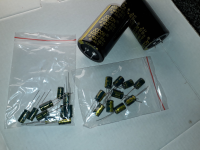
You could enlarge the pic, as I could of enlarged my budget, but the more costly eastern big caps got worse reviews. I don't think the two bags of green esr caps are dishonest, and the big caps are also barely worth faking, but who knows. They didn't offer a ripple figure, and I can't measure 8200uf. I hope they are all better than broken one's though.
3000h main caps with 6amp ripple would of been over £10 each locally. I didn't want to put £30 down on a half job. If my friend likes it, they can pay for a blanket replacement. I really need to get a handle on the fault first though.
If I fail here, it's scope time, then the ES range if I swap them in the signal path. I'm very happy with the reviews of the ES caps for this job, and have no reason to look up the price ladder. Likewise the opamps used, seem perfectly adequate, or even perfect, considering the CD being played was very possibly mastered using them.
Calculating possible values to replace the audio caps, is indeed beyond my knowledge today. With no schematic, it would be a lot of work, and the ES seems right anyway. I missed the boat on higher voltage ratings this time, but the ES are higher for the same package size. These 8200uf 80v caps are actually bigger than the originals though. Same spec, but 70mm tall not 60mm. I'm hopeful it's a good sign. Though perhaps it just indicates more paper wrapped around the 1000uf hidden within.
Ten Quid

You could enlarge the pic, as I could of enlarged my budget, but the more costly eastern big caps got worse reviews. I don't think the two bags of green esr caps are dishonest, and the big caps are also barely worth faking, but who knows. They didn't offer a ripple figure, and I can't measure 8200uf. I hope they are all better than broken one's though.
3000h main caps with 6amp ripple would of been over £10 each locally. I didn't want to put £30 down on a half job. If my friend likes it, they can pay for a blanket replacement. I really need to get a handle on the fault first though.
If I fail here, it's scope time, then the ES range if I swap them in the signal path. I'm very happy with the reviews of the ES caps for this job, and have no reason to look up the price ladder. Likewise the opamps used, seem perfectly adequate, or even perfect, considering the CD being played was very possibly mastered using them.
Calculating possible values to replace the audio caps, is indeed beyond my knowledge today. With no schematic, it would be a lot of work, and the ES seems right anyway. I missed the boat on higher voltage ratings this time, but the ES are higher for the same package size. These 8200uf 80v caps are actually bigger than the originals though. Same spec, but 70mm tall not 60mm. I'm hopeful it's a good sign. Though perhaps it just indicates more paper wrapped around the 1000uf hidden within.
- Home
- Amplifiers
- Solid State
- Roksan Kandy MkIII and Scope advice sort